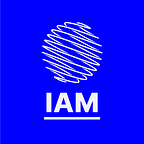The Futures of Niche Publications
In this series on From Complexity to Emergence, we’re recapping the IAM Weekend 16 and bringing you everything we learned and explored in one place. At our next edition in April, we’ll be discussing The Renaissance of Utopias across media, education and the arts. Join us!
Independent by name, independent by nature. The rise of indie publications is well documented, but these modern day journals are setting a new course for both print and digital by forming communities, working across borders and promoting subversive, illuminating thoughts all based around a single, niche idea.
Nowhere is this clearer than with Oslo-based magazine Recens Paper. Founded by Elise by Olsen, Recens was created to protest the commercialisation, beauty standards and gender stereotypes of the mainstream fashion industry. As a youth culture magazine, its penchant for railing against the trends and traditions of the creative industries even extends to its design, manifested in its upside down cover.
At the IAM Weekend 16, Elise spoke with Recens’ Art Director Morteza Vaseghi about the importance of creating content that’s relevant and sensitive towards today’s youth. Through this process, Recens unites a community of trendsetters and game-changers that is both boundary-less and age-less (Elise is 16, Morteza is 34). This organic network is also self-supporting, providing a platform for those who would otherwise miss out on valuable opportunities while affirming that experimentation and error are paths to success as equally as they are to failure. Now on its fifth issue, Elise and Mori can confidently say: “the youth invents future.”
The network behind contemporary publications is fundamental, but producing content is only half the story. Getting magazines into the hands of the right people — both current fans and potential followers — is just as difficult, if not even more so. In comes Stack Magazines, founded by IAMW16 speaker Steven Watson. So far, a self-fulfilling ecosystem of small, independent businesses has been built, with shops and magazines existing in symbiosis. But this only goes so far. Not every shop is a beautiful store that understands the indie mag market, and as technology has made publishing more accessible it has also made the market more competitive.
In response, Stack is a subscription service that sends a new print magazine to subscribers’ doors every month, celebrating the independent and distinctive nature of every publication. To that end, Steven believes that the various niches explored within sell themselves, and that magazines shouldn’t copy one other but embrace this even further. Through Sampler, Stack’s sister service, customers are offered even more choice (new magazines are available every week), and the two services together represent an innovative new standard of distribution. Publishers can build their audiences and engage with a community of magazine-lovers, and in turn convince them to become future customers. With the future looking evermore saturated, it’s precisely this sort of thinking that will ensure the ongoing survival of magazines, and print itself.
In both print and digital, niche publications are strongest when they bring a unique, intelligent perspective to their field. With Brownbook Magazine, founders Ahmed & Rashid bin Shabib do exactly this by challenging mainstream media narratives about the Middle East and sharing the stories of those who often go unheard. Both online and offline, Brownbook’s approach speaks to the need for focussed, contemporary content which prioritises quality and integrity, and as Rashid emphasised at the IAM Weekend, it’s this investigative, research-driven writing which stands out against the increasing commodification of journalism.
As the digital shift forces content-makers to think about relevance, a strong focus on quality facilitates a slick online/offline relationship where physical and digital work in tandem, not against each other. With the old model of large publishing houses trying to cover many topics slowly crumbling, Rashid highlighted the opportunity for independent publishers to the resulting void; only by doubling-down on their niche can contemporary mag-makers can be more targeted and nimble.
An empowered community, innovative distribution and quality content. But how can publishers make it pay? Freunde von Freunden, co-founded by Frederik Frede, follows the growing trend seen with the likes of Monocle and Winkreative, VICE and Virtue and It’s Nice That and Anyways, by having a sister agency in the form of MoreSleep. As Frederik explained, while MoreSleep creates commercial work for clients, FvF shares tales of creativity with people at the centre of every feature, and in doing so has built a reputation for authentic, inspirational storytelling.
At the centre of this approach is FvF’s commitment to timeless content. Frederik drew attention to the fact that you can revisit each story on the FvF website months and years after it was first published, and it will still be valuable, relevant and engaging. Combined with its global community of contributors, the weight attached to authentic, quality content has allowed FvF to build a reputation for uplifting stories that are also attractive to brands, providing a further source of revenue. Together, FvF and MoreSleep build on each other’s distinguished reputations to create one business model, and in doing so outline a sustainable model for future publishing.
The future will present many an obstacle for niche publishing — be it content production, distribution, developing a community, financial sustainability or anything in between — but Recens, Stack, Brownbook and FvF are plotting a new route for publications to follow. As we learned from each of them, by embracing what makes them unique, magazines both online and offline can not only rise to the challenges of the future but redefine the future of publishing itself.
